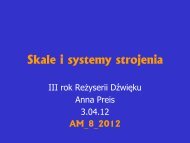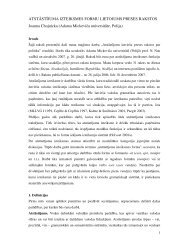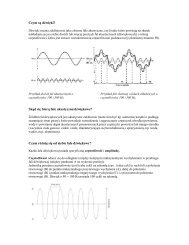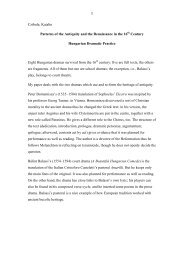Richard Carew. The Ordinary, The Ordinalia, and the Ordinary Actor ...
Richard Carew. The Ordinary, The Ordinalia, and the Ordinary Actor ...
Richard Carew. The Ordinary, The Ordinalia, and the Ordinary Actor ...
Create successful ePaper yourself
Turn your PDF publications into a flip-book with our unique Google optimized e-Paper software.
<strong>Carew</strong>'s <strong>Ordinary</strong> 30<br />
9. A Medieval Staging Convention?<br />
Because “evaluating <strong>Carew</strong>’s description on <strong>the</strong> basis of <strong>the</strong> extant plays seems<br />
counterproductive,” as Betcher puts it,112 proponents of <strong>Carew</strong>’s description have<br />
underst<strong>and</strong>ably avoided engaging with <strong>the</strong> extant guare-mirkle texts. Instead, it has seemed more<br />
productive to view “prompting in full view of <strong>the</strong> audience” as a “medieval staging convention.”<br />
This tactic both broadens <strong>the</strong> significance of <strong>the</strong> claim–it is no longer to be regarded just an<br />
obscure Cornish convention–<strong>and</strong> makes it unnecessary to defend <strong>the</strong> specific details of <strong>Carew</strong>’s<br />
description. Even if <strong>Carew</strong> plainly thinks that <strong>the</strong> Cornish <strong>Ordinary</strong>’s activities are so peculiar that<br />
he has to explain <strong>the</strong>m to an English readership, never<strong>the</strong>less <strong>the</strong> “convention” can still be<br />
described. <strong>Carew</strong> may think that <strong>the</strong> Cornish version of <strong>the</strong> onstage prompter is peculiar, but<br />
perhaps he would have regarded o<strong>the</strong>r versions of <strong>the</strong> onstage director as quite normal, indeed<br />
conventional.<br />
<strong>The</strong> difficulty with this approach, of course, is that onstage directors are very hard to find.<br />
Butterworth has tried to document instances of onstage direction in <strong>the</strong> medieval <strong>and</strong> Early<br />
Modern period. He has come up with a list of nine such examples. None of <strong>the</strong>m, however, bear<br />
examination. We have already considered one of <strong>the</strong>se, <strong>the</strong> Conveyour, at some length. We can, I<br />
think, dispose of <strong>the</strong> o<strong>the</strong>r eight more briefly.<br />
Let us begin with <strong>the</strong> four pictorial illustrations that he has found. Butterworth is in good<br />
company in thinking that Fouquet’s Martyrdom of St Apollonia depicts a fifteenth-century French<br />
meneur du jeu directing a mystère. This <strong>the</strong>ory, however, rests on nothing more substantial than a<br />
flash of inspiration by <strong>the</strong> brilliant French scholar, Gustave Cohen, one that simply cannot be<br />
substantiated, not even in <strong>the</strong> production book for <strong>the</strong> Mons Passion–Cohen calls it le Livre de<br />
Conduite du Régisseur–where he thought he had found traces of his presence. To <strong>the</strong> contrary,<br />
that text provides considerable evidence to rule out such an onstage director, <strong>and</strong> <strong>the</strong>re is no o<strong>the</strong>r<br />
documentary evidence for such a regisseur toujours sur les planches (an always onstage<br />
director),as he calls him, anywhere else in France.113 <strong>The</strong>re is, indeed, good reason to think that<br />
Fouquet’s image means to illustrate a classical Roman performance, as described by Isidore de<br />
Seville, where a poet declaimed <strong>the</strong> text while actors mimed <strong>the</strong> action.114<br />
<strong>The</strong> reappearance of <strong>the</strong> blue-coated, bookholding figure in Fouquet’s Rape of <strong>the</strong> Sabine<br />
Women illustrates frequent practice in Fouquet’s atelier of reusing figures from an earlier painting<br />
in a later one, but o<strong>the</strong>rwise it tells us nothing about <strong>the</strong> performance of an onstage director. <strong>The</strong><br />
bookholding figure appears as a tiny figure, recessed into <strong>the</strong> background where he is not<br />
obviously directing anything <strong>and</strong> st<strong>and</strong>s motionless contemplating an idol atop a column. Far<br />
from an illustration of a medieval <strong>the</strong>atre, as some suggest, <strong>the</strong> image clearly illustrates a Roman<br />
circus; its obvious, deeply-oval shape is required for horse racing, <strong>and</strong> <strong>the</strong> pillar with its idol<br />
serves as one of <strong>the</strong> two meta around which <strong>the</strong> horses turned in <strong>the</strong> race.<br />
Nei<strong>the</strong>r Hubert Cailleau’s image of one of <strong>the</strong> Valenciennes superintendants nor <strong>the</strong><br />
portrait of a fancifully behatted Jakob Ruf are depicted as onstage directors. <strong>The</strong> Valenciennes<br />
superintendant carries a small scroll ra<strong>the</strong>r than a book. His image is framed by <strong>the</strong> text of <strong>the</strong><br />
legal contract that binds actors to obey <strong>the</strong> superintendant <strong>and</strong> lists penalties for disobeying <strong>the</strong>m.<br />
He carries a scroll <strong>and</strong> staff as symbols of his authority: <strong>the</strong> scroll in one h<strong>and</strong> represents <strong>the</strong> very<br />
legal contract that frames his image; it grants him <strong>the</strong> authority symbolized by his staff, which he
















